How to drain condensate from a household gas cylinder: the nuances of condensation formation + instructions for draining
Is there enough for every refueling of your gas cylinder for a shorter period of time? Or maybe you noticed a deterioration in the quality of the flame - the burner puffs and goes out from time to time? The reason for this may be the condensate that has accumulated in the tank after many refueling. If it is drained and high-quality gas is pumped at a specialized gas station, gas appliances from a cylinder will work no worse than from a central gas pipeline: stable, even and without soot.
In this article, we will understand what gas condensate is, where it comes from in the cylinder, whether it is necessary to get rid of it, and, most importantly, how to drain the condensate from a household gas cylinder on its own.
The content of the article:
What condenses in a gas cylinder?
You can often notice that the gas in the tank is over, and at the bottom something continues to splash. Some people think it’s still a little liquefied gas, just for some reason it does not go out and does not light up, but this is not so. In fact, after using all the gas in the cylinder, condensate - a residue that does not go into a gaseous state at room temperature, and therefore does not come out under pressure and does not provide combustion.
To understand why condensation forms in your gas tank, let's figure out what it consists of.
The liquid that remains at the bottom of the cylinder after using all the gas, as a rule, consists of several components.
Among them may be:
- Gasoline - non-volatile petroleum products, a cross between butane and gasoline.
- Odorant - gas flavoring.
- Non-combustible impurities - it is not uncommon to use insufficiently purified gas or to refuel from an almost empty tank.
- Water - the rarest, but also the most dangerous component in this case.
- Butane - if the bottle was used in cold weather.
The amount of such impurities present in the propane-butane mixture and forming condensate directly depends on the quality of the filling of the balloon, as well as on the time of year.
Propane at normal pressure turns into gas even at a temperature of -30 degrees, and butane - at 1 degree below zero.
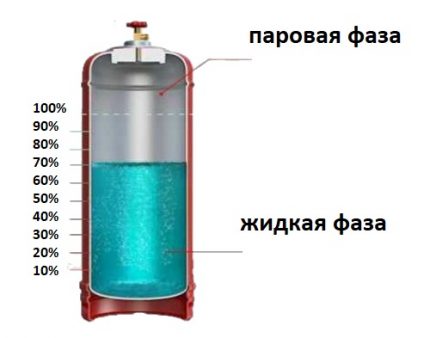
However, there are other oil refining products, the boiling point of which is much higher: +30 - +90 degrees and above. That is, when heated to a sufficient temperature, they will behave the same as propane and butane - it’s just dangerous to heat a gas cylinder. And at room temperature, and even with increased pressure inside the container, they remain in a liquid state, forming condensate.
Under normal conditions, these non-volatile fractions are called gasoline, and the better the gas at the gas station, the lower their percentage.
In addition to gasoline, an odorant is always present in the propane-butane technical mixture, which is filled with household gas cylinders. This is a special substance, ethyl mercoptan, with an extremely strong pungent odor: it is added in order to notice a leak in time and manage to prevent the accumulation of gas in the room. In addition to the odor of odorant, it is possible to detect a gas leak in a timely manner and analyze the composition of the gas mixture using special equipment - gas analyzer.
Without the addition of an odorant, the gas mixture would have no odor - just like purified propane, pure butane, or natural gas. The odorant is also non-combustible, so it remains in the condensate. Its volume is negligible, because by the standards add 6 - 9 ml of flavoring per 100 kg of liquefied gas. However, after using the container, it remains almost completely in the condensate, due to a decrease in the total mass of substances, its concentration increases.
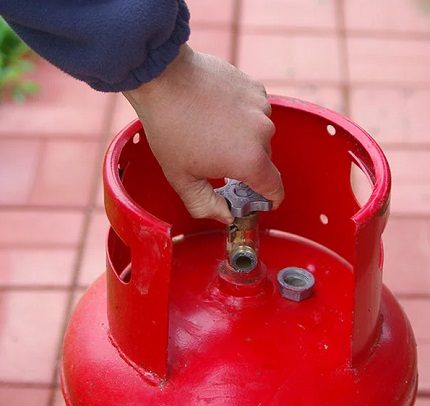
Normally, there should be no water or non-combustible impurities in the gas. However, when refueling at unverified stations, anything happens, so we called these condensate components. Water in a gas cylinder is dangerous in that it provokes corrosion of the inner surface of the metal. The cylinder is not painted inside, and therefore easily rusts, and it is impossible to control this process. Such rust is detected only when it eats through the metal - and this is already too late and extremely dangerous.
Butane is added to household gas cylinders in a smaller amount than propane: in summer, their ratio is about 2: 3, and in winter - at least 2: 8. This is only subject to refueling at a specialized station, and not automobile gas. As we have already mentioned, butane, unlike propane, does not turn into gas at low temperatures, so a cylinder installed on the street may end earlier than expected.
If you used bottled gas in late autumn or winter, especially if it was filled in the summer, try to bring the cylinder into the room after the gas is no longer supplied. Most likely, after its contents have warmed to room temperature, you can use it for some more time.
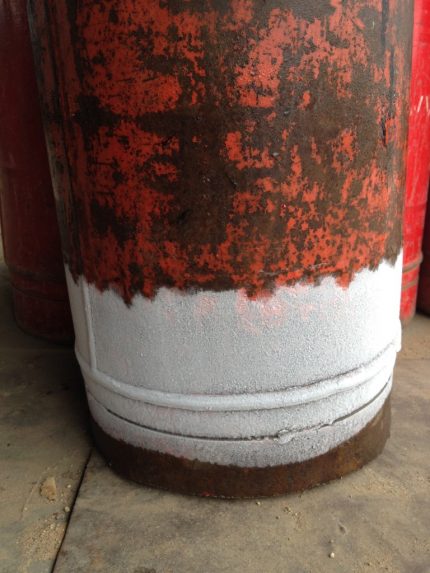
You don’t need to do anything with condensate or hoarfrost outside the container, this moisture can only be damaged by the container on which the paint layer is damaged: with prolonged and regular exposure, the steel of the container can begin to rust, and corrosion can lead to leakage, fire and even gas cylinder explosion.
However, this will take quite a lot of time, so the user's task is limited to maintaining a uniform and high-quality color.
Frequency of condensate drain from a cylinder
But when do you need to drain the condensate? This question is very individual and depends on the quality of the refueling gas, operating conditions.
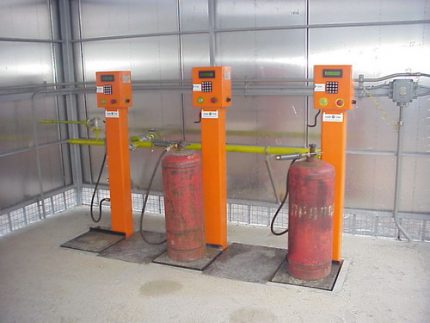
Many users of gas cylinders did not encounter such a need at all, while others do it before each refueling. Both of these extremes are normal behavior under certain conditions, and to determine which is closer to you, we will consider these conditions in more detail.
Option # 1 - refueling at a specialized substation
If you refuel a cylinder at a specialized substation, you may not encounter condensate at all, for several reasons at once. Firstly, they are charged with the “right” gas, with a high content of propane, and not just cheap butane, like at gas stations.
Secondly, their gas quality control is much stricter, so the degree of gas purification is higher, and there are practically no foreign impurities.
Thirdly, at most such substations, the cylinders are exchanged, and before refueling, they are inspected and serviced, discarded excessively worn out, and after refueling, they are monitored for safety and tightness. Including, substation workers drain condensate if it has accumulated in the cylinder.
Even if you insist on refueling your particular tank, they won’t fulfill it, having not previously verified the serviceability and safety of the unit. The fact is that specialized substations operate officially, observing norms and technical requirements for refueling, are responsible for the safety of each client.
Option # 2 - refueling at the gas station station
Cylinders refueling at gas stations but used for domestic purposes are much more prone to condensation.
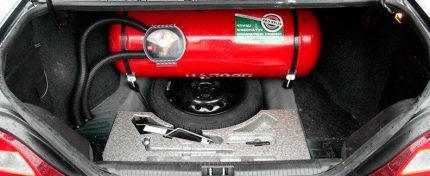
If the bottle seasoned at gas stationput home, all impurities and weakly volatile gases will settle at the bottom, and remain there in the form of condensate. Therefore, when refueling with automobile gas, condensate must be drained at least every 3 to 4 refuelings, and preferably before each.
Separately, we can mention the small tourist gas canisters, up to 1 liter. They have a different output, reminiscent of a can for refueling lighters, and it’s difficult and unsafe to do something with it yourself except for its intended purpose. However, many craftsmen do the cans yourself.
Although, in principle, it is more convenient and simpler when such cartridges are filled only at specialized points, with the correct composition of gas and a high degree of purification, therefore, condensate does not form in them. Yes, and they are relatively inexpensive, and do not serve for decades, like big brothers, so when such a can begins to junk, usually just buy a new one.
Condensate drain instructions
If we neglect the condensate drain procedure, less and less gas will be placed in the cylinder each time, and it will not last so long. In addition, the bay is the normal amount gas mixture in a cylinderwhere condensate has already accumulated, you risk filling it to the eyeballs without leaving the required 15% of the void for the gas cushion. This is extremely dangerous and fraught with balloon rupture or explosion at the slightest additional heating or shaking.
To prevent undesirable consequences, let's figure out together how to properly clean a household gas cylinder from condensate.
So, first of all, it is necessary to use or discharge the remaining gas.
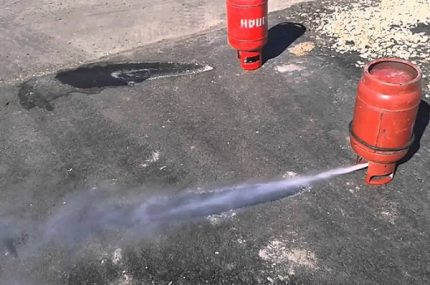
If the tile or other equipment is already working poorly from this cylinder, puffs, you can simply bleed gas on the street. For this, uncheck gearbox and gradually open the valve. In no case do this near a house, fire, wiring, sparks, in a limited space: a meadow or field where there are no people and the wind will quickly disperse the gas is ideal.
Violation of this simple rule can lead to poisoning, fire or explosion - do not risk your health and others. Keep in mind that when a large amount of propane-butane passes from a liquid state to a gaseous state, the remaining liquid cools down very much and the cylinder becomes cold.
When, at the opening of the tap, the characteristic hissing ceases to be heard, we can say that the gas is over. That is, it remained only in a gaseous, and not liquid state, exactly the same volume as the cylinder, so the pressure is not higher than atmospheric, and it does not come out. Most likely, even at this stage, something will splash in the cylinder - this is condensation.
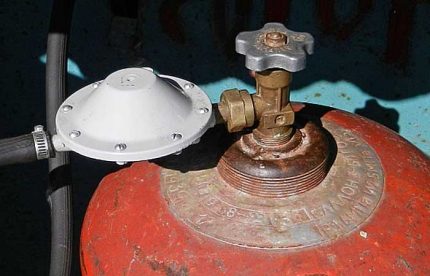
To get rid of condensation, do this:
- Choose a place remote from housing and fire hazard factors, preferably - not sown field and not the shore of a reservoir. Ideal is a wasteland, wild meadow. You can not drain the condensate directly near the gas station, where you are going to fill the cylinder.
- If the gearbox is still in place, remove it.
- It is advisable to prepare a glass or metal can, which can be tightly closed together with the drained substance.
- Open the tap and find the pipe under it where the gearbox was attached.
- Turn the container upside down, this pipe from you, directing it to the prepared container. For convenience, you can put a hose on it.
- If the fluid does not leak, or if not all has been drained, tilt and shake the bottle so that the last milliliters leak.
- Be sure to close the valve so that the cylinder is not filled with air and moisture.
It is advisable that after this procedure nothing splashes in the cylinder. Sometimes you may come across a recommendation to fry empty cylinders in the sun with open valves to remove both condensate residues and water that could get into the cylinder. But this procedure can be unsafe, especially if you forget to open the valve, and the extra few milliliters of condensate will not play a role, therefore it is better not to dry the cylinders if necessary.
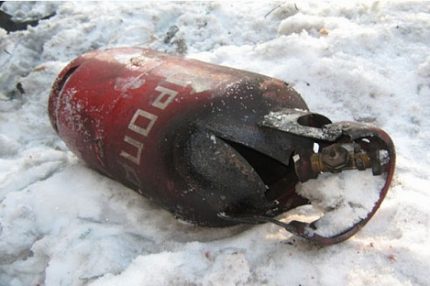
With proper use of water, there is nowhere to come from, so you don’t have to figure out how to properly drain water from a household gas cylinder, and drying is not required.
Safety precautions for handling a cylinder
Gas cylinders are extremely dangerous. Annually explode, destroying housing and killing people, tens and hundreds of household gas cylinders, and in most cases the violation is the fault rules of their operation.
Refueling gas legally, at a specialized substation, together with a full cylinder, you will receive a memo on its safe transportation, storage and use. Among other things, it is forbidden to install cylinders closer than half a meter from the gas stove or one meter from the stove, heater or battery.
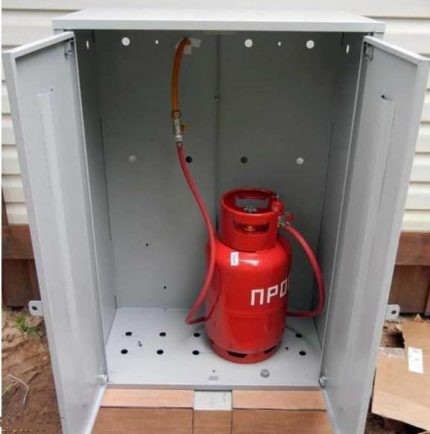
Do not allow the cylinders to heat up - from any devices or in the sun - this is fraught with their rupture.Also, they cannot be stored in a tightly closed cabinet without ventilation at the bottom of the doors: in the event of a leak, gas will fill the cabinet, and when combined with oxygen from the air, the mixture becomes extremely explosive. The slightest spark or electric discharge is enough, and there will be an explosion.
We also recommend that you read the article:Why gas cylinders explode: the main causes of accidents.
You should not use a winter gas mixture, with a high content of propane, in the summer: it will evaporate too actively, and the balloon may swell or even burst due to excessive pressure - and this is with 3 mm thick steel walls.
The use of inflated, crumpled or damaged cylinders is also prohibited: there is no guarantee that it is leakproof and can withstand a gas pressure of up to 8 bar.
Conclusions and useful video on the topic
So that there are definitely no questions left, we suggest watching a video on how condensate is drained from an empty cylinder:
Using gas cylinders in everyday life, do not forget about the need for their maintenance, because this is a matter of your safety. Draining condensate and checking integrity yourself or entrusting it to professionals is up to you, and we told you how to do it efficiently and safely.
Do you use gas cylinders and do you still have condensation after using gas? Tell us how you get rid of it - the feedback form is located below.
If you still have questions or would like to express your opinion on the advisability of condensate drain at home, please join the discussion on the topic.

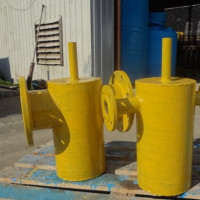 Gas condensate collectors on the gas pipeline: structure and purpose of the condensate collector + nuances of installation and maintenance
Gas condensate collectors on the gas pipeline: structure and purpose of the condensate collector + nuances of installation and maintenance 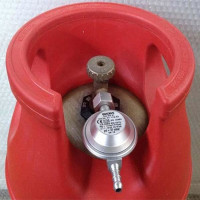 What is a gas cylinder reducer: device and operation of the device with a pressure regulator
What is a gas cylinder reducer: device and operation of the device with a pressure regulator  Characteristics of typical 50 liter gas cylinders: design, dimensions and weight of the cylinder
Characteristics of typical 50 liter gas cylinders: design, dimensions and weight of the cylinder  How to disassemble a gas cylinder: step by step instructions + precautions
How to disassemble a gas cylinder: step by step instructions + precautions  DIY gas grill: step-by-step instructions for building a homemade product
DIY gas grill: step-by-step instructions for building a homemade product 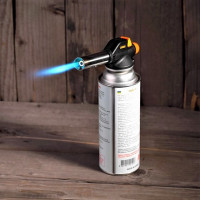 Gas burners for spray can: varieties and principle of operation + nuances of choice and use
Gas burners for spray can: varieties and principle of operation + nuances of choice and use  How much does it cost to connect gas to a private house: the price of organizing gas supply
How much does it cost to connect gas to a private house: the price of organizing gas supply  The best washing machines with dryer: model rating and customer tips
The best washing machines with dryer: model rating and customer tips  What is the color temperature of light and the nuances of choosing the temperature of the lamps to suit your needs
What is the color temperature of light and the nuances of choosing the temperature of the lamps to suit your needs  Replacement of a geyser in an apartment: replacement paperwork + basic norms and requirements
Replacement of a geyser in an apartment: replacement paperwork + basic norms and requirements